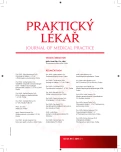Current treatment of liver abscess – Experience of Surgical Clinic of University Hospital Pilsen
Authors:
J. Fichtl; V. Třeška; J. Vodička; T. Skalický; A. Sutnar; D. Šmíd
Authors‘ workplace:
Přednosta: prof. MUDr. Vladislav Třeška, DrSc.
; Chirurgická klinika LF UK a FN, Plzeň
Published in:
Prakt. Lék. 2015; 95(1): 12-15
Category:
Of different specialties
Overview
Introduction:
Liver abscesses are a special nosological unit which can be found particularly in immunocompromised patients and elderly people being over eighty. This also causes high morbidity of patients and it caused mortality in the past, as well. These are mostly pyogenic abscesses, i.e. abscesses of bacterial origin (cCa 80%), remaining 20% are uniformly represented by abscesses made up of modus and parasites. The originators of pyogenic abscess are most frequently Streptococcus miller and S. faecalis, Escherichia coli and Klebsiella pneumoniae.
Objective:
The retrospective analysis of a group of patients treated for liver abscess in the Department of Surgery and the Department of Internal Medicine of University Hospital in Pilsen.
Methodology:
From 2007 to 2012, 54 patients with the diagnosis of liver abscess were hospitalized in the Department of Surgery of University Hospital and Faculty of Medicine of Charles University in Pilsen. There were more men (35 patients – 64.8%) than women (19 patients – 35.2%), the average age was 64 in the range of 28–87. There was a research of primary procedure at treatment as well as patients’ age, aetiology of abscess, morbidity, mortality and the duration of hospitalization.
Results:
From the etiological point of view, it was most of ten an access with no provable cause, e.i.primary one (26 cases – 48.1%). Infectious agents were identified by cultivation tests in 45 cases (83.3%). The cause of bacterial abscesses was mostly Escherichia coli (16 cases – 29.6%). The drainage by means of CT navigation was a sufficient surgery for 31 patients (57.4%). In 14 patients (25.9%), open drainage was a primary surgery. One half of patients had some complications, mortality of this disease reached 3.7%. The average duration of hospitalization was 18.5 days.
Conclusion:
Liver abscess has to be taken into account within differential diagnostics of septic temperatures with pain under right rib. The basis of diagnosis are clinical and laboratory examinations, ultrasonography and computer tomography. Regarding treatment, the method of choice is drainage navigated by CT and use of broad-spectrum antibiotics. Open surgical drainage is performed in case of focuses being inaccessible for radiology frequency and in patients who react to their previous therapy in an insufficient way. In consideration with its seriousness and small incidence, the treatment of liver abscesses belongs to specialized centres of liver surgery.
Keywords:
liver abscess – CT drainage – antibiotics
Sources
1. Bammigatti C, Ramasubramanian NS, Kadhiravan T, Das AK. Percutaneous needle aspiration in uncomplicated amebic liver abscess: a randomized trial. Trop Doct 2013; 43: 19–22.
2. Cerwenka H. Pyogenic liver abscess: differences in etiology and treatment in Southeast Asia and Central Europe. World J Gastroenterol 2010; 20(16): 2458–2462.
3. Fischer JE, Bland KI, Callery MP, et al. Mastery of Surgery. 5th Ed. Philadelphia: Lippincott Williams & Wilkins 2007; 1033–1035.
4. Gain T, Lorenz R, Classen M. Sonographic percutaneous drainage of liver abscesses. Med Klin (Munich) 1990; 85(10): 577–580.
5. Garden J. Hepatobiliary and pancreatic surgery. 4th. Ed. Edinburgh: Saunders 2009; 65–67.
6. Karatassas A, Williams JA, Aust NZJ. Review of pyogenic liver abscess at the Royal Adelaide Hospital 1980–1987. Surg 1990; 60(11): 893–897.
7. Klener P, a kol. Vnitřní lékařství. 4.vyd. Praha: Galén 2011; 598–690.
8. Mangukiya DO, Darshan JR, Kanani VK, Gupta ST. A prospective series case study of pyogenic liver abscess: recent trands in etiology and management. Indian J Surg 2012; 74(5): 385–390.
9. Pang TCY, Fung T, Samra J, et al. Pyogenic liver abscess: An audit of 10 years’ experience. World J Gastroenterol 2011; 17(12):1622–1630.
10. Skalický T, Třeška V, Šnajdauf J, a kol. Hepatopankreatikobiliární chirurgie. Praha: Maxdorf 2011; 35(68): 212.
11. Swallow CJ, Rotstein OD. Management of pyogenic liver abscess in the era of computed tomography. Can J Surg 1990; 33(5): 355–362.
12. Zeman M, a kol. Speciální chirurgie. 1. vyd. Praha: Galén 2001; 240–242.
Labels
General practitioner for children and adolescents General practitioner for adultsArticle was published in
General Practitioner

2015 Issue 1
- Memantine Eases Daily Life for Patients and Caregivers
- Metamizole vs. Tramadol in Postoperative Analgesia
- Metamizole at a Glance and in Practice – Effective Non-Opioid Analgesic for All Ages
- Memantine in Dementia Therapy – Current Findings and Possible Future Applications
- What Effect Can Be Expected from Limosilactobacillus reuteri in Mucositis and Peri-Implantitis?
Most read in this issue
- Current treatment of liver abscess – Experience of Surgical Clinic of University Hospital Pilsen
- Clostridial phlegmona of the abdominal wall in an obese patient with Crohn’s disease
- Viral haemorrhagic fevers
- The impact of the holocaust on the health of survivors
